Are you looking for a guard dog who can keep a close eye on your property and your family? It’d also be great if that dog was low-shedding too, right?
You’re probably wondering, where do you find such a canine? Well, I've done the research for you, and here’s a list of six low shedding, protective breeds:
- Black Russian Terrier
- Giant Schnauzer
- Puli
- Cane Corso
- Spanish Water Dog
- Komondor
Although every dog sheds at least to some extent, the six breeds above are noteworthy for less blown hair throughout your house. On top of that, they’re reliable for their keen eye and sharp senses. Keep reading for more information on these extraordinary canines!
1. Black Russian Terrier
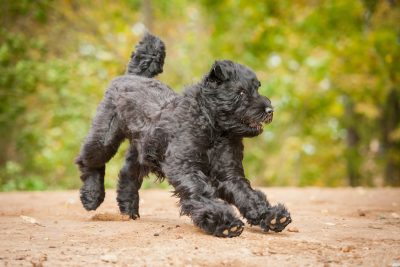
Starting this list is the Black Russian Terrier, a dog that can grow 28 inches tall, both males and females. The BRT, as he’s called, is big enough that anyone who dares traipse around your premises will quickly be scared off.
You too might feel nervous about the size of the BRT and what that means for the breed’s rate of shedding, but you’d be surprised! Although the Black Russian Terrier is a bear of a pet, he sheds moderately during most of the year.
The dog’s seasonal shedding will be more though. At least it’s only twice a year!
Grooming your BRT is going to be tough. The dog requires brushing with a slicker brush about every other day to control loose hair and prevent tangles and matted fur.
Every couple of months, you’ll have to trim the hair around your Black Russian Terrier’s face too so your dog can see.
Recommended: Go here to see our top-rated dog hair blow dryers
2. Giant Schnauzer

The Giant Schnauzer certainly lives up to its name, let me tell you! This dog is about 28 inches tall and weighs up to 110 pounds (males).
The breed’s M.O. is all about protecting its family, keeping a close eye on the goings-on in and outside of your home.
Giant Schnauzers will shed more than Miniature Schnauzers, of course, but they’re not a heavily shedding breed, per se. Molting occurs, which causes your dog to lose its fur and grow new hairs, and some seasonal shedding happens too.
Although you won’t expend as much effort into maintaining your Giant Schnauzer’s coat as you would a BRT, the Schnauzer’s care isn’t exactly effortless either. Their coat is dense and wiry, so use a slicker brush daily to several times per week.
Some Giant Schnauzer owners will hand strip their dogs, which entails pulling out their fur by hand. Don’t forget to trim your dog too, especially since the Giant Schnauzer’s coat can get very unruly around its legs, ears, and face.
Recommended: Go here to see our top-rated dog hair blow dryers
3. Puli
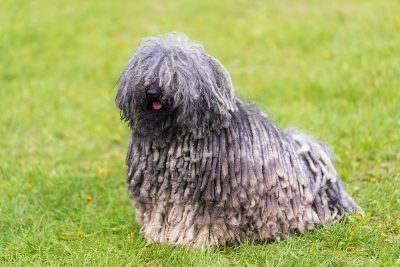
Next on the list is a dog with a rather unique coat called the Puli. He’s the first of three breeds on this list with what are known as corded coats.
A corded coat looks like dreadlocks all over the dog’s head and body. Each of those dreadlocks is known as a cord. The cords can trap in loose hair before it ever coats your carpet or couch, making you a happy dog owner.
Grooming a Puli is going to be a pain in the you-know-what. As a puppy, until the dog reaches about 10 months old, you can forego grooming a Puli outside of regular baths.
Then the dog requires you to go through each cord and pull out any loose, heavy mats of fur. Pull the cords every six months and not any more infrequently than nine months.
For some dog owners, it’s better than brushing, although pulling cords is more time-consuming. At least in the time you get to leave the cords alone, all you have to worry about is bathing your Puli occasionally.
So what makes the Puli a good guard dog? Bred to guard livestock, the Puli is eager to keep its favorite people safe.
4. Cane Corso
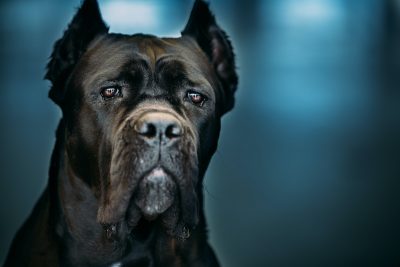
How about a protective dog that’s easier to groom? That would be the Cane Corso, a huge companion dog that can reach sizes of nearly 28 inches tall.
The dog’s name comes from a Latin term that means “bodyguard dog,” so that should tell you enough!
The Cane Corso is very muscular and kind of scary to those who don’t know the dog. Yet behind the imposing exterior, the Cane Corso is a teddy bear who’s even good around kids.
As a Mastiff dog, the Cane Corso sheds less than you’d expect. He still undergoes some seasonal shedding, but not as much molting during the rest of the year.
When it comes to keeping this large dog tidy, as I said before, it’s not intensive. Using a rubber brush or a bristle brush on the dog about weekly, you can maintain the Cane Corso’s coat. A deshedding tool will come in handy when seasonal shifts are on the horizon.
5. Spanish Water Dog

Here’s another great dog to have on your radar, the Spanish Water Dog.
Full to the brim of tightly-wound curls, this mid-sized dog can grow cords not unlike the Puli. Between the coarseness of its fur and those curls, shedding is not an issue you’ll have to worry about with the Spanish Water Dog.
Attesting to its herding history, the Spanish Water Dog is a hard worker with intelligence, strong senses, and alertness for hours. Fewer things should go wrong around the house with one of these dogs close by.
Of course, since the Spanish Water Dog has tight curls as well as some cords, its coat maintenance will be difficult and time-consuming. Don’t brush the coat, and if the fur is corded, then don’t trim it either.
Pulling the coat of a Spanish Water Dog isn’t the same as doing it for a Puli. You’re looking for weak, matted areas of fur. Then you have to pull that out. This method is sort of like hand stripping but not quite.
If you’re not comfortable with maintaining a Spanish Water Dog, I’d suggest taking your pup to a groomer. Make sure the groomer specializes in Spanish Water Dogs!
Recommended: Go here to see our top-rated dog hair blow dryers
6. Komondor
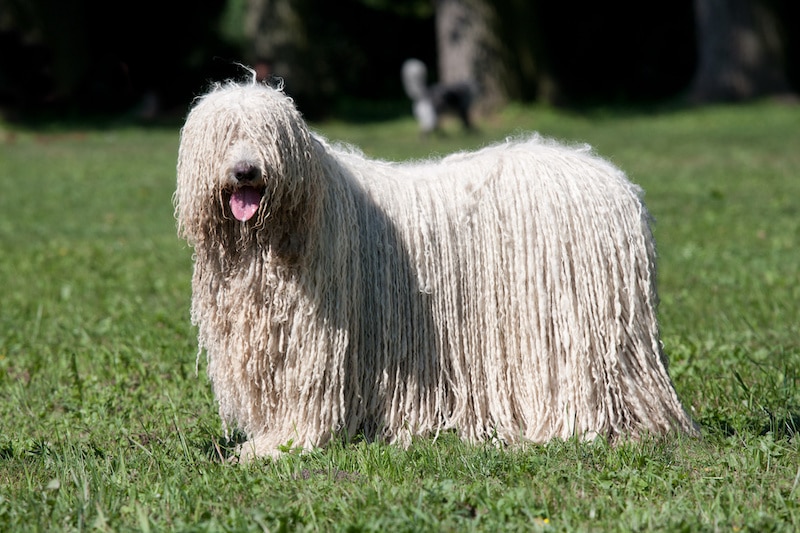
Nope, I’m not quite done talking about corded dogs yet. The last protective dog that doesn’t shed is the Komondor, a shaggy but endearing pup that weighs up to 100 pounds and stands nearly 28 inches tall.
Admittedly, the Komondor isn’t very imposing with its shaggy curls, but its protective nature means you can rely on the Komondor to keep a watchful eye on your family.
You should know by now based on its coat that the Komondor won’t shed much. Its cords grab onto the loose fur.
A Komondor’s coat will begin to get clumpy at about 10 months old. By dividing those clumps early, the areas of clumped fur will become cords.
To maintain the cords, avoid brushing them, but do wash your Komondor about once a month.
Bottom Line
Guard dogs are wonderful. They not only provide companionship but protection as well. Although guard dogs are bigger breeds, the 6 dogs I talked about today prove that large dogs don’t always have to shed heaps.
The dogs on this list also demonstrate that even though a watchdog has a tough side, a lot of these breeds are big softies on the inside!
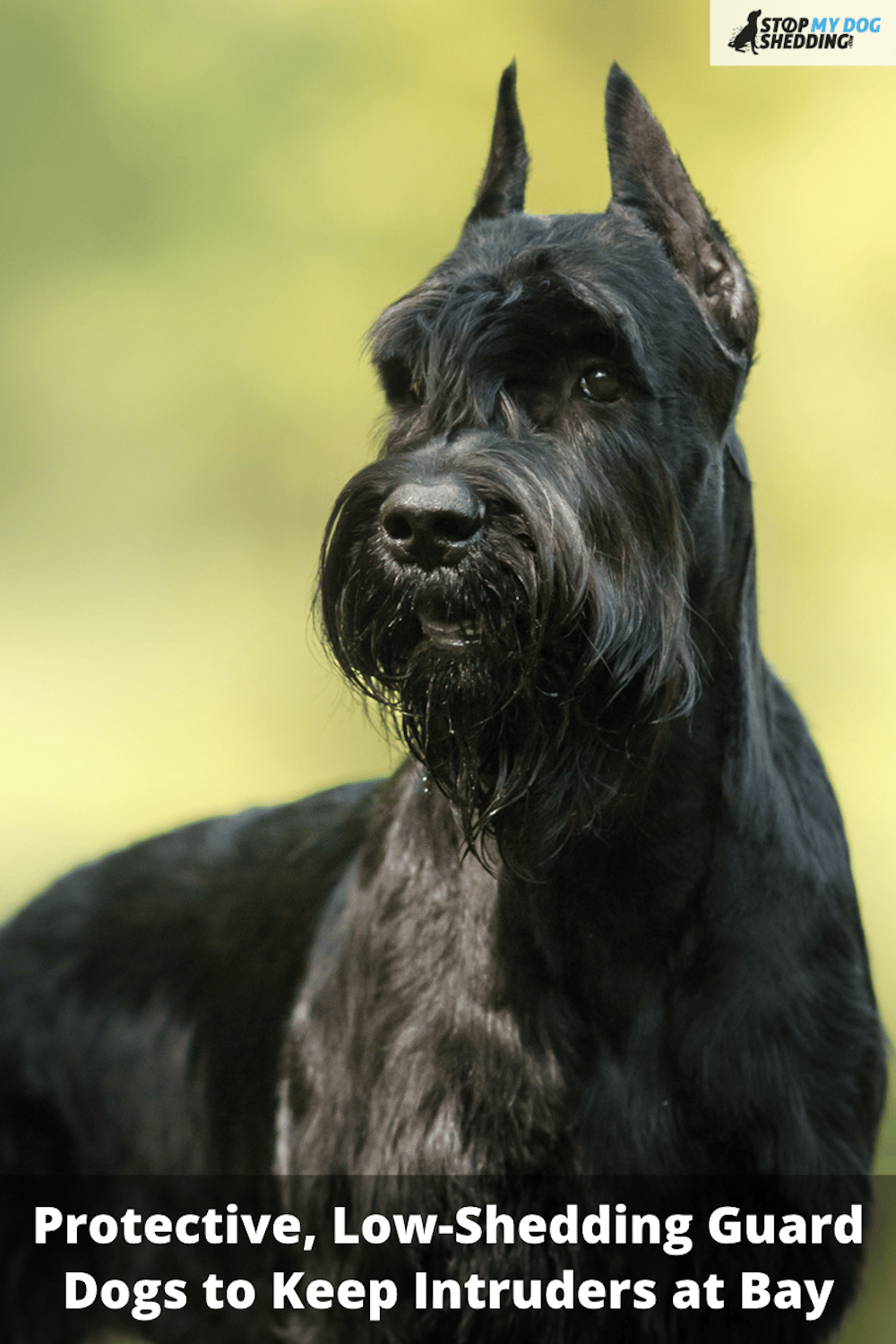

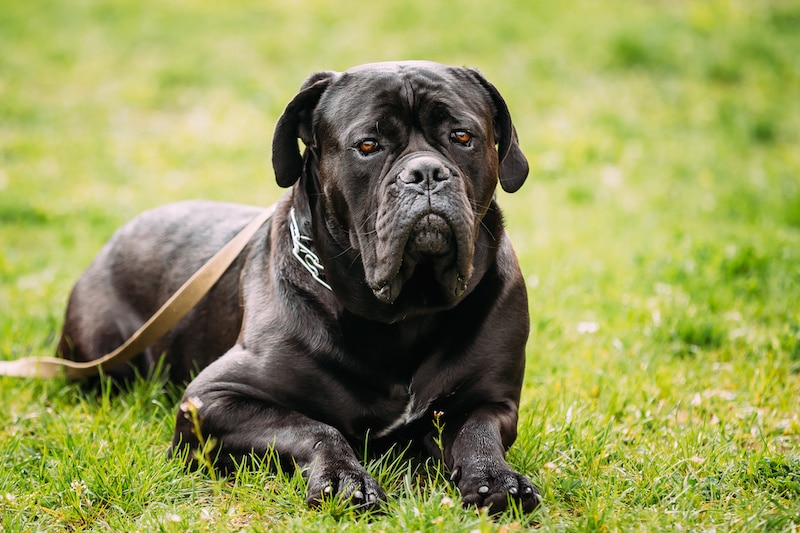










Please note: By submitting a comment using the above comment form, you confirm that you agree with the storage and handling of your data by this site as detailed in our Privacy Policy.